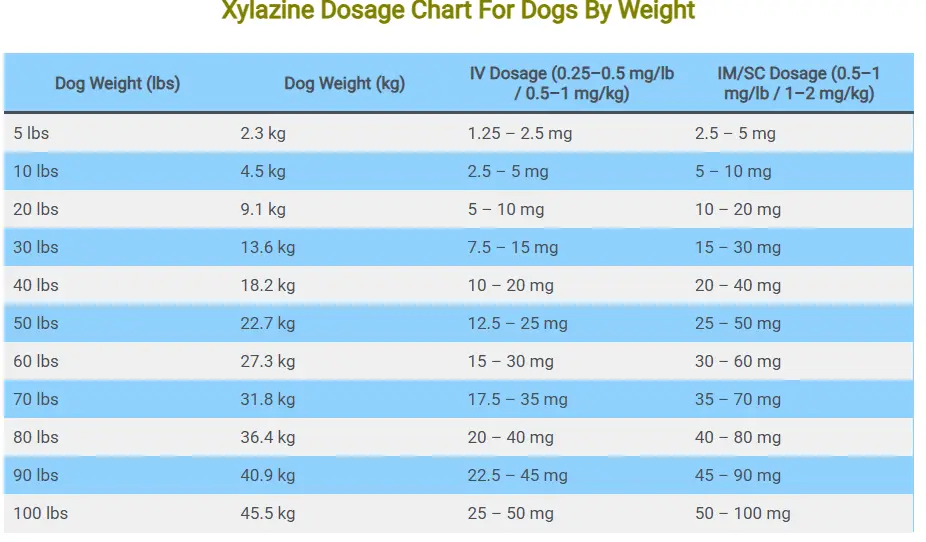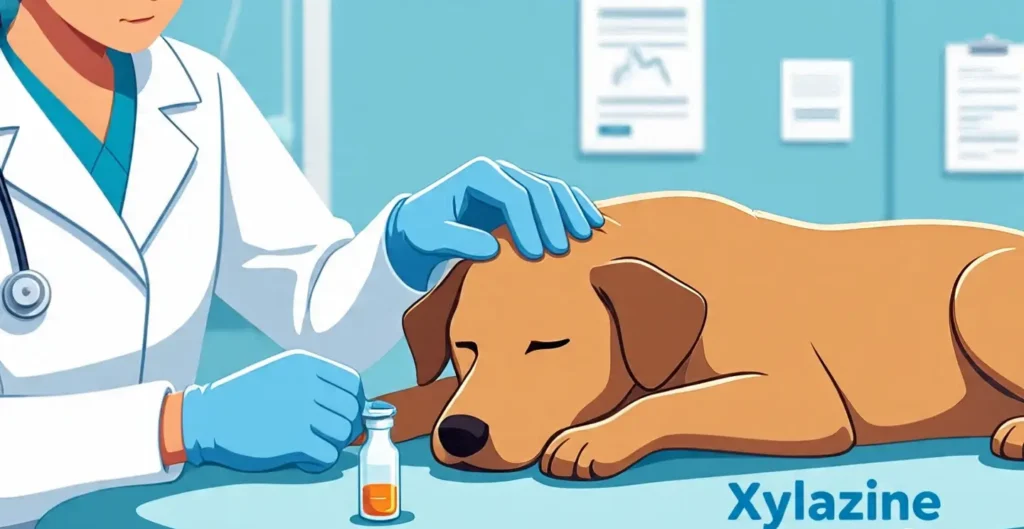Xylazine for dogs is a widely recognized veterinary drug that plays a vital role in managing animal care, particularly for dogs. Developed originally as a sedative and analgesic for large animals like horses and cattle, veterinarians quickly realized its effectiveness in smaller animals when administered correctly. Unlike typical over-the-counter sedatives or pain relievers, xylazine is a prescription-only medication and is classified as an alpha-2 adrenergic agonist.
This means it interacts with specific receptors in a dog’s nervous system to induce sedation, muscle relaxation, and pain relief.
In veterinary practice, xylazine is commonly used for pre-anesthetic sedation, minor surgical procedures, and situations where a dog needs to be calmed or immobilized for safety. It allows vets to perform diagnostics, wound treatments, or imaging scans without stress for the animal or risk of injury for the handlers.
However, the key aspect that sets xylazine apart from other sedatives is its potency and narrow margin of safety. Unlike milder sedatives, xylazine requires precise dosing based on weight, breed type, and overall health condition. A small miscalculation in dosage can lead to serious complications, which is why veterinarians emphasize careful monitoring during and after its administration.
For dog owners, understanding how xylazine works and why it’s used is important—not for at-home use, but to be informed about what their pet may receive at the clinic. The more informed you are, the more confident you’ll feel when discussing treatment options with your vet.
Xylazine Dose For Dogs
For sedation in dogs, the typical xylazine dosage is 0.25 to 0.5 mg per pound (0.5 to 1 mg/kg) when given intravenously (IV), or 0.5 to 1 mg per pound (1 to 2 mg/kg) when administered intramuscularly (IM) or subcutaneously (SC). The exact dose depends on the dog’s weight, health condition, and intended use, and it should only be prescribed and administered by a licensed veterinarian.
Xylazine Dosage Chart For Dogs By Weight
| Dog Weight (lbs) | Dog Weight (kg) | IV Dosage (0.25–0.5 mg/lb / 0.5–1 mg/kg) | IM/SC Dosage (0.5–1 mg/lb / 1–2 mg/kg) |
|---|---|---|---|
| 5 lbs | 2.3 kg | 1.25 – 2.5 mg | 2.5 – 5 mg |
| 10 lbs | 4.5 kg | 2.5 – 5 mg | 5 – 10 mg |
| 20 lbs | 9.1 kg | 5 – 10 mg | 10 – 20 mg |
| 30 lbs | 13.6 kg | 7.5 – 15 mg | 15 – 30 mg |
| 40 lbs | 18.2 kg | 10 – 20 mg | 20 – 40 mg |
| 50 lbs | 22.7 kg | 12.5 – 25 mg | 25 – 50 mg |
| 60 lbs | 27.3 kg | 15 – 30 mg | 30 – 60 mg |
| 70 lbs | 31.8 kg | 17.5 – 35 mg | 35 – 70 mg |
| 80 lbs | 36.4 kg | 20 – 40 mg | 40 – 80 mg |
| 90 lbs | 40.9 kg | 22.5 – 45 mg | 45 – 90 mg |
| 100 lbs | 45.5 kg | 25 – 50 mg | 50 – 100 mg |
Factors that influence xylazine dose in dogs
- Dog’s weight: The most critical factor, since overdose risk is high in small dogs.
- Health condition: Dogs with compromised heart, liver, or kidney function may need lower doses or alternative sedatives.
- Purpose of use: Whether the goal is mild sedation, deep sedation, or surgical anesthesia.
- Drug combinations: Xylazine is often paired with other anesthetics like ketamine, reducing the required dose.
Veterinary guidelines provide general ranges, but every dosage decision is individualized. For example, a 20-pound dog receiving xylazine for diagnostic sedation may need a much lower dose than the same dog undergoing a surgical procedure.
This is why accuracy in weight measurement is crucial. Even being off by just a few pounds can change the correct dosage, especially in smaller breeds. Veterinarians typically weigh dogs immediately before administration to avoid guesswork.
Side Effects and Risks of Xylazine in Dogs
Like any powerful drug, xylazine comes with potential side effects. While many dogs handle it well under supervision, owners should know what risks exist.
Common Side Effects:
- Drowsiness and lethargy
- Vomiting soon after injection
- Slower heart rate
- Drop in blood pressure
Serious Risks (Less Common but Dangerous):
- Breathing difficulties
- Seizures
- Abnormal heart rhythms
- Sudden collapse in overdose cases
Because of these risks, vets never use xylazine without having emergency reversal agents available. Drugs like yohimbine and atipamezole can counteract xylazine’s effects if the dog reacts badly.
Pet owners should also be aware that after xylazine sedation, their dog may remain groggy for several hours. Providing a quiet, warm recovery space and monitoring them closely is crucial.
Signs of Xylazine Overdose in Dogs
Overdose is one of the biggest dangers when it comes to xylazine. Unlike mild sedatives, a small miscalculation in dosage can quickly push a dog from safe sedation into life-threatening complications.
Signs of Overdose Include:
- Extremely slow or irregular heartbeat
- Shallow or absent breathing
- Seizures or convulsions
- Loss of consciousness or coma
- Pale gums and weak pulse
If an overdose occurs, immediate veterinary intervention is necessary. Reversal drugs are often administered, along with oxygen therapy and IV fluids. The faster a dog receives help, the better the chances of survival.
This is why pet owners must never attempt to use xylazine at home. What might look like a “mild sedative” is actually a drug that can shut down a dog’s vital systems in minutes if used improperly.
How Xylazine Works in Dogs
Xylazine works by targeting alpha-2 adrenergic receptors in the central nervous system. These receptors help regulate the release of norepinephrine, a neurotransmitter responsible for arousal, alertness, and stress responses. When xylazine binds to these receptors, it reduces norepinephrine release, effectively calming the nervous system.
The result? Sedation, analgesia (pain relief), and muscle relaxation. This triple effect makes xylazine extremely useful in veterinary medicine. For example, during a wound cleaning procedure, a dog not only stays calm but also experiences reduced pain and minimized muscle movement.
Xylazine has both benefits and limitations. Its benefits include predictable sedation, reliable pain management, and reduced need for higher-risk anesthetics in minor procedures. But limitations exist too—such as its tendency to depress cardiovascular and respiratory functions. That’s why vets often use xylazine in combination with other drugs like ketamine, which balances out some of the drawbacks while enhancing anesthesia.
It’s worth noting that xylazine does not work the same in all dogs. Factors like age, breed, and existing health issues play a huge role in how effective and safe the drug is. For instance, brachycephalic breeds (short-nosed dogs like Bulldogs) may be more prone to breathing issues when given sedatives like xylazine.
Safety Considerations Before Using Xylazine
Before a veterinarian decides to use xylazine on a dog, several safety checks are essential. Unlike basic medications, xylazine can’t just be given without thorough evaluation. Here’s what vets typically look at:
- Pre-Examination: The vet checks vital signs, heart health, and respiratory function. Dogs with pre-existing conditions may face greater risks.
- Dogs to Avoid Xylazine: Pregnant dogs, those with heart or liver disease, and very young puppies are usually excluded from receiving xylazine because of the high chance of complications.
- Potential Side Effects: While sedation is expected, side effects can include vomiting, low blood pressure, slow heart rate, and difficulty breathing. Severe overdoses can even result in seizures or coma if not treated quickly.
Because of these risks, xylazine is always administered in a controlled veterinary setting with monitoring equipment available. Emergency drugs such as yohimbine or atipamezole—both xylazine reversal agents—are often kept on hand in case of an adverse reaction.
For pet owners, the takeaway is simple: xylazine should never be administered at home. It is not a routine sedative you can keep in a cabinet—it’s a powerful veterinary drug that requires medical oversight every time it’s used.
Xylazine Administration Methods in Dogs
Xylazine is not a one-size-fits-all medication; how it’s given makes a huge difference in its effectiveness and safety. Veterinarians choose the administration route carefully based on the dog’s size, health status, and the intended procedure.
1. Injectable Administration
The most common way xylazine is administered is through injection. Vets usually use intramuscular (IM) or intravenous (IV) routes.
- IM injection is slower-acting but gentler, making it a safer option for dogs that don’t need immediate deep sedation.
- IV injection works much faster and produces more profound effects but comes with greater risks if not closely monitored.
2. Combination with Other Drugs
Xylazine is often paired with ketamine, acepromazine, or opioids. This combination lowers the dose of each drug needed, minimizing risks while enhancing sedation and analgesia.
3. Why Oral Use Isn’t Safe
Unlike some sedatives, xylazine is not prescribed orally for dogs. It has poor absorption and unpredictable results when swallowed, not to mention a much higher chance of overdose.
In clinical settings, the vet doesn’t just administer the drug and walk away. They continuously monitor breathing, heart rate, and reflexes to ensure the dog stays safe throughout the procedure.
Comparing Xylazine to Other Veterinary Sedatives
When it comes to sedating dogs, veterinarians have several choices. Xylazine is powerful, but it isn’t always the best or only option. Let’s break down how it compares to other common sedatives:
1. Xylazine vs. Acepromazine
- Acepromazine is a milder tranquilizer often used for routine sedation or anxiety.
- Xylazine provides stronger sedation and pain relief but carries higher risks.
2. Xylazine vs. Dexmedetomidine (Dexdomitor)
- Dexmedetomidine is considered a safer, newer alternative with more predictable effects.
- Xylazine is more affordable, which is why some clinics still use it.
3. Xylazine vs. Benzodiazepines (Diazepam/Midazolam)
- Benzodiazepines relax muscles and reduce anxiety but offer minimal pain relief.
- Xylazine combines sedation, analgesia, and muscle relaxation all in one.
Ultimately, the choice of drug depends on the dog’s health, the procedure, and the vet’s experience. Sometimes, xylazine is preferred because of its potency; other times, safer alternatives are chosen.
Xylazine in Emergency Veterinary Care
Interestingly, while xylazine carries risks, it also has life-saving applications in emergencies. In situations where a dog is aggressive due to pain or trauma, xylazine may be the only safe way to sedate them for treatment.
For example, in accident cases where a dog has multiple fractures and cannot be handled, xylazine allows vets to provide pain relief and stabilize the animal quickly. In surgical emergencies, it’s often used as part of a rapid anesthesia protocol.
Another use is in seizure management. While not a first-line drug, xylazine has been employed in extreme cases when standard anticonvulsants fail. Its sedative effect can sometimes break seizure cycles and prevent further damage.
These uses show that xylazine, when handled correctly, is not just a risky sedative but a powerful tool that can save lives. The key lies in professional administration and careful monitoring.
Special Considerations for Different Dog Breeds
Not all dogs respond to xylazine in the same way. Breed-specific traits can significantly influence how safe and effective the drug is.
1. Small Breeds (Toy Dogs, Terriers, Chihuahuas, etc.)
- Much more sensitive to xylazine.
- Even tiny dose miscalculations can lead to overdose.
- Extra caution is required with monitoring and reversal agents.
2. Large and Giant Breeds (Great Danes, Mastiffs, etc.)
- Surprisingly, these dogs often need proportionally lower doses because of their slower metabolisms.
- Too high of a dose can quickly overwhelm their cardiovascular systems.
3. Brachycephalic Breeds (Bulldogs, Pugs, Shih Tzus, etc.)
- Higher risk of respiratory complications.
- Vets may avoid xylazine altogether in these breeds and opt for safer alternatives.
4. Working and Sporting Breeds (Border Collies, Retrievers, etc.)
- Generally tolerate sedatives better but may require higher precision in dosage because of their lean muscle mass.
This is why vets never rely on “one-size-fits-all” charts. Breed-specific risks always come into play when determining sedation plans.
Long-Term Effects of Xylazine Use in Dogs
Xylazine is typically used as a short-term sedative, but what about repeated exposure over time? While most dogs only receive it occasionally (such as for surgery or diagnostics), long-term or repeated use can pose risks.
Potential Long-Term Issues Include:
- Liver strain: Frequent sedation can burden the liver as it processes the drug.
- Tolerance: Over time, a dog may require higher doses for the same effect, increasing risks.
- Behavioral changes: Some dogs may develop temporary anxiety or disorientation after multiple sedations.
Fortunately, most dogs do not receive xylazine often enough to face these problems. Still, vets try to limit its use by rotating sedatives or using alternatives when possible.
You May Also Like To Read:
FAQs
Can I give xylazine to my dog at home?
No. Xylazine should never be administered outside a veterinary clinic. It is a powerful drug that requires professional monitoring, emergency equipment, and access to reversal agents. Administering it at home could be fatal.
How long does xylazine last in dogs?
The sedative effects usually last between 30 minutes to 2 hours, depending on dosage and whether reversal agents are used. Some grogginess or lethargy may persist for several more hours.
Is xylazine safe for all breeds?
Not exactly. Small breeds, brachycephalic breeds, and dogs with heart, liver, or respiratory issues face higher risks. In such cases, vets often prefer safer alternatives like dexmedetomidine.
Can xylazine be combined with other medications?
Yes. Xylazine is frequently paired with ketamine, opioids, or benzodiazepines to achieve balanced anesthesia while minimizing risks. However, only a veterinarian can determine the right combination.
What should I do if I suspect my dog received too much xylazine?
Seek immediate veterinary care. Symptoms of overdose include slowed breathing, very weak pulse, seizures, or unconsciousness. Emergency treatment with reversal agents and supportive care is the only way to prevent life-threatening outcomes.











![Can Dogs Eat Blood? 7 Side Effects [Expert Opinion]](https://petskor.com/wp-content/uploads/2022/04/Webp.net-resizeimage-12.jpg)
